NSB102: Person-Centered Care and Cultural Safety in Dementia Analysis
VerifiedAdded on 2023/03/23
|12
|3481
|36
Essay
AI Summary
This essay provides a comprehensive analysis of dementia care within the Australian healthcare system, emphasizing the principles of cultural safety and person-centered care. It explores various types of healthcare delivery for individuals living with dementia, including primary healthcare, Dementia Behavior Management Advisory Service (DBMAS), and Cognitive Dementia and Memory Service (CDAMS). The essay also addresses the social determinants of health, particularly poverty, and its significant impact on people with dementia, highlighting the financial challenges and the need for long-term care management. Furthermore, it applies relevant codes and standards from the Australian Nursing and Midwifery Council to promote cultural safety and ethical practice, advocating for the protection of the fundamental rights of disabled persons and caregivers while combating stigma and discrimination within the community.
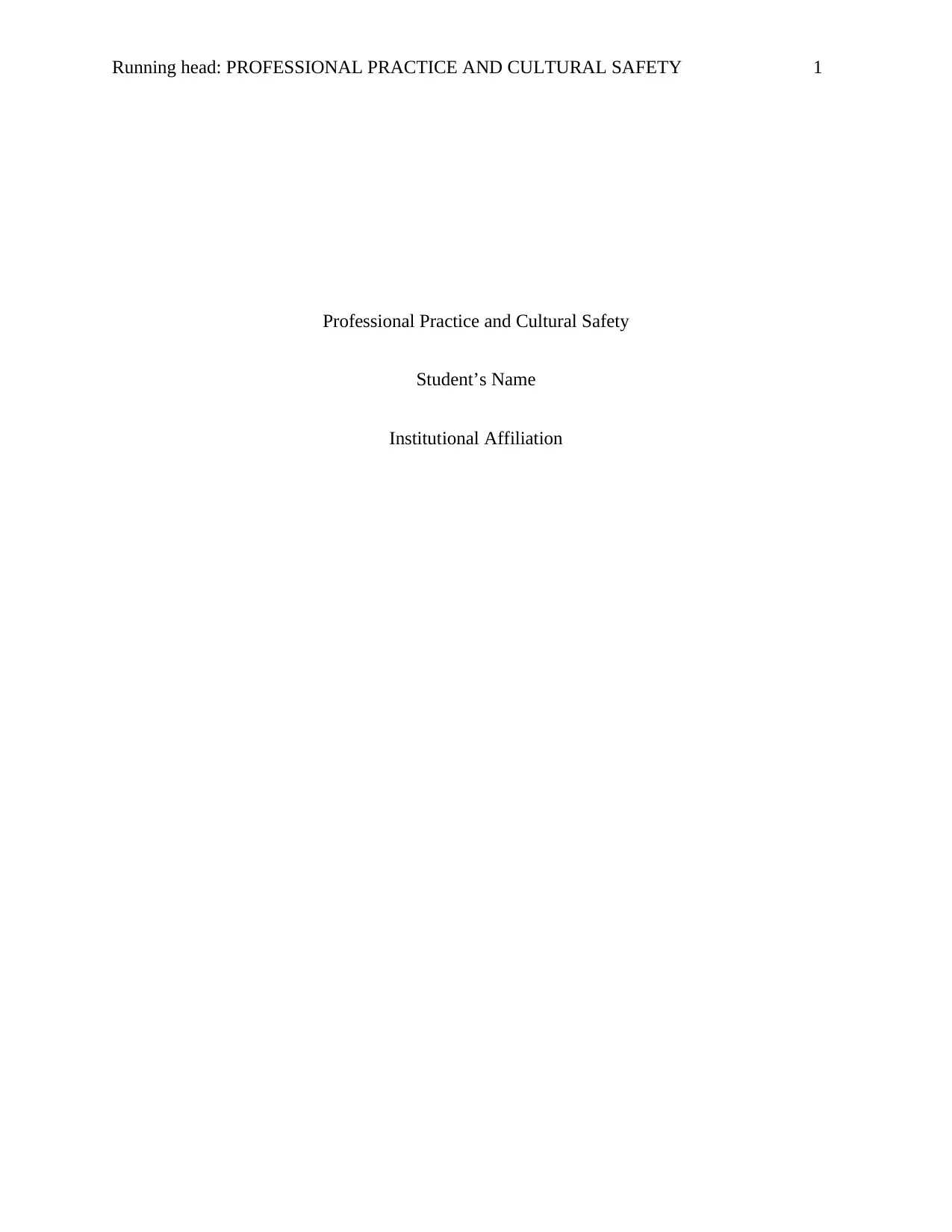
Running head: PROFESSIONAL PRACTICE AND CULTURAL SAFETY 1
Professional Practice and Cultural Safety
Student’s Name
Institutional Affiliation
Professional Practice and Cultural Safety
Student’s Name
Institutional Affiliation
Paraphrase This Document
Need a fresh take? Get an instant paraphrase of this document with our AI Paraphraser
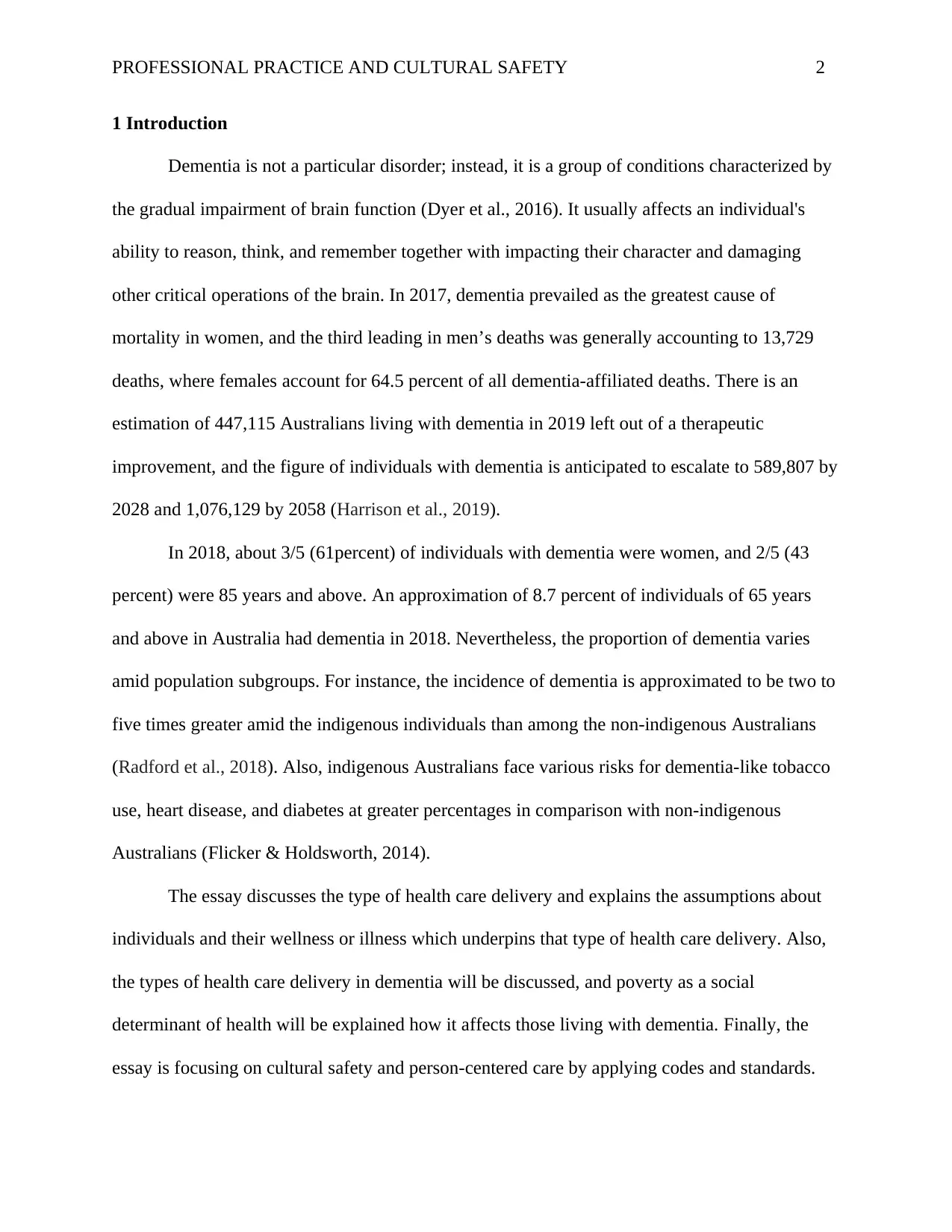
PROFESSIONAL PRACTICE AND CULTURAL SAFETY 2
1 Introduction
Dementia is not a particular disorder; instead, it is a group of conditions characterized by
the gradual impairment of brain function (Dyer et al., 2016). It usually affects an individual's
ability to reason, think, and remember together with impacting their character and damaging
other critical operations of the brain. In 2017, dementia prevailed as the greatest cause of
mortality in women, and the third leading in men’s deaths was generally accounting to 13,729
deaths, where females account for 64.5 percent of all dementia-affiliated deaths. There is an
estimation of 447,115 Australians living with dementia in 2019 left out of a therapeutic
improvement, and the figure of individuals with dementia is anticipated to escalate to 589,807 by
2028 and 1,076,129 by 2058 (Harrison et al., 2019).
In 2018, about 3/5 (61percent) of individuals with dementia were women, and 2/5 (43
percent) were 85 years and above. An approximation of 8.7 percent of individuals of 65 years
and above in Australia had dementia in 2018. Nevertheless, the proportion of dementia varies
amid population subgroups. For instance, the incidence of dementia is approximated to be two to
five times greater amid the indigenous individuals than among the non-indigenous Australians
(Radford et al., 2018). Also, indigenous Australians face various risks for dementia-like tobacco
use, heart disease, and diabetes at greater percentages in comparison with non-indigenous
Australians (Flicker & Holdsworth, 2014).
The essay discusses the type of health care delivery and explains the assumptions about
individuals and their wellness or illness which underpins that type of health care delivery. Also,
the types of health care delivery in dementia will be discussed, and poverty as a social
determinant of health will be explained how it affects those living with dementia. Finally, the
essay is focusing on cultural safety and person-centered care by applying codes and standards.
1 Introduction
Dementia is not a particular disorder; instead, it is a group of conditions characterized by
the gradual impairment of brain function (Dyer et al., 2016). It usually affects an individual's
ability to reason, think, and remember together with impacting their character and damaging
other critical operations of the brain. In 2017, dementia prevailed as the greatest cause of
mortality in women, and the third leading in men’s deaths was generally accounting to 13,729
deaths, where females account for 64.5 percent of all dementia-affiliated deaths. There is an
estimation of 447,115 Australians living with dementia in 2019 left out of a therapeutic
improvement, and the figure of individuals with dementia is anticipated to escalate to 589,807 by
2028 and 1,076,129 by 2058 (Harrison et al., 2019).
In 2018, about 3/5 (61percent) of individuals with dementia were women, and 2/5 (43
percent) were 85 years and above. An approximation of 8.7 percent of individuals of 65 years
and above in Australia had dementia in 2018. Nevertheless, the proportion of dementia varies
amid population subgroups. For instance, the incidence of dementia is approximated to be two to
five times greater amid the indigenous individuals than among the non-indigenous Australians
(Radford et al., 2018). Also, indigenous Australians face various risks for dementia-like tobacco
use, heart disease, and diabetes at greater percentages in comparison with non-indigenous
Australians (Flicker & Holdsworth, 2014).
The essay discusses the type of health care delivery and explains the assumptions about
individuals and their wellness or illness which underpins that type of health care delivery. Also,
the types of health care delivery in dementia will be discussed, and poverty as a social
determinant of health will be explained how it affects those living with dementia. Finally, the
essay is focusing on cultural safety and person-centered care by applying codes and standards.
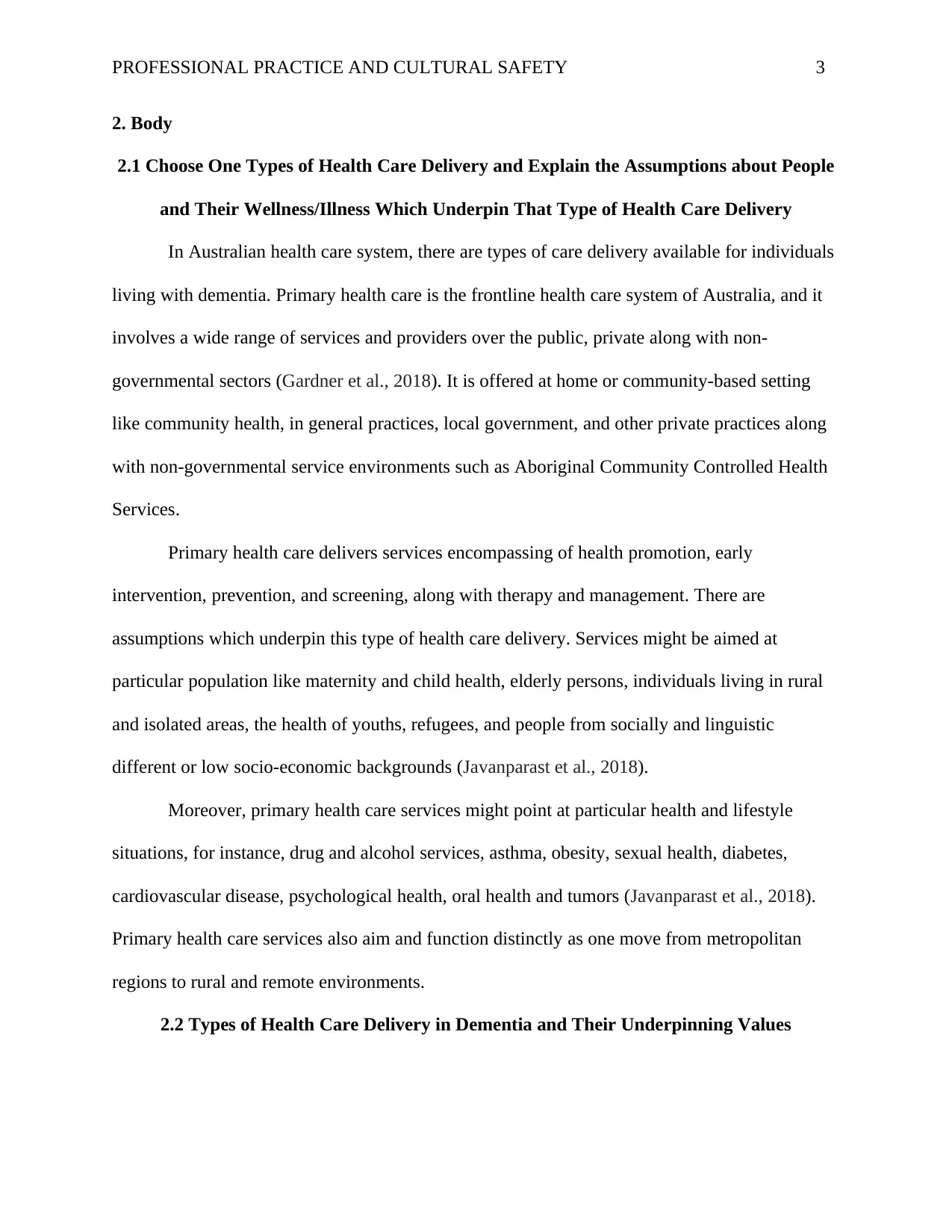
PROFESSIONAL PRACTICE AND CULTURAL SAFETY 3
2. Body
2.1 Choose One Types of Health Care Delivery and Explain the Assumptions about People
and Their Wellness/Illness Which Underpin That Type of Health Care Delivery
In Australian health care system, there are types of care delivery available for individuals
living with dementia. Primary health care is the frontline health care system of Australia, and it
involves a wide range of services and providers over the public, private along with non-
governmental sectors (Gardner et al., 2018). It is offered at home or community-based setting
like community health, in general practices, local government, and other private practices along
with non-governmental service environments such as Aboriginal Community Controlled Health
Services.
Primary health care delivers services encompassing of health promotion, early
intervention, prevention, and screening, along with therapy and management. There are
assumptions which underpin this type of health care delivery. Services might be aimed at
particular population like maternity and child health, elderly persons, individuals living in rural
and isolated areas, the health of youths, refugees, and people from socially and linguistic
different or low socio-economic backgrounds (Javanparast et al., 2018).
Moreover, primary health care services might point at particular health and lifestyle
situations, for instance, drug and alcohol services, asthma, obesity, sexual health, diabetes,
cardiovascular disease, psychological health, oral health and tumors (Javanparast et al., 2018).
Primary health care services also aim and function distinctly as one move from metropolitan
regions to rural and remote environments.
2.2 Types of Health Care Delivery in Dementia and Their Underpinning Values
2. Body
2.1 Choose One Types of Health Care Delivery and Explain the Assumptions about People
and Their Wellness/Illness Which Underpin That Type of Health Care Delivery
In Australian health care system, there are types of care delivery available for individuals
living with dementia. Primary health care is the frontline health care system of Australia, and it
involves a wide range of services and providers over the public, private along with non-
governmental sectors (Gardner et al., 2018). It is offered at home or community-based setting
like community health, in general practices, local government, and other private practices along
with non-governmental service environments such as Aboriginal Community Controlled Health
Services.
Primary health care delivers services encompassing of health promotion, early
intervention, prevention, and screening, along with therapy and management. There are
assumptions which underpin this type of health care delivery. Services might be aimed at
particular population like maternity and child health, elderly persons, individuals living in rural
and isolated areas, the health of youths, refugees, and people from socially and linguistic
different or low socio-economic backgrounds (Javanparast et al., 2018).
Moreover, primary health care services might point at particular health and lifestyle
situations, for instance, drug and alcohol services, asthma, obesity, sexual health, diabetes,
cardiovascular disease, psychological health, oral health and tumors (Javanparast et al., 2018).
Primary health care services also aim and function distinctly as one move from metropolitan
regions to rural and remote environments.
2.2 Types of Health Care Delivery in Dementia and Their Underpinning Values
⊘ This is a preview!⊘
Do you want full access?
Subscribe today to unlock all pages.

Trusted by 1+ million students worldwide
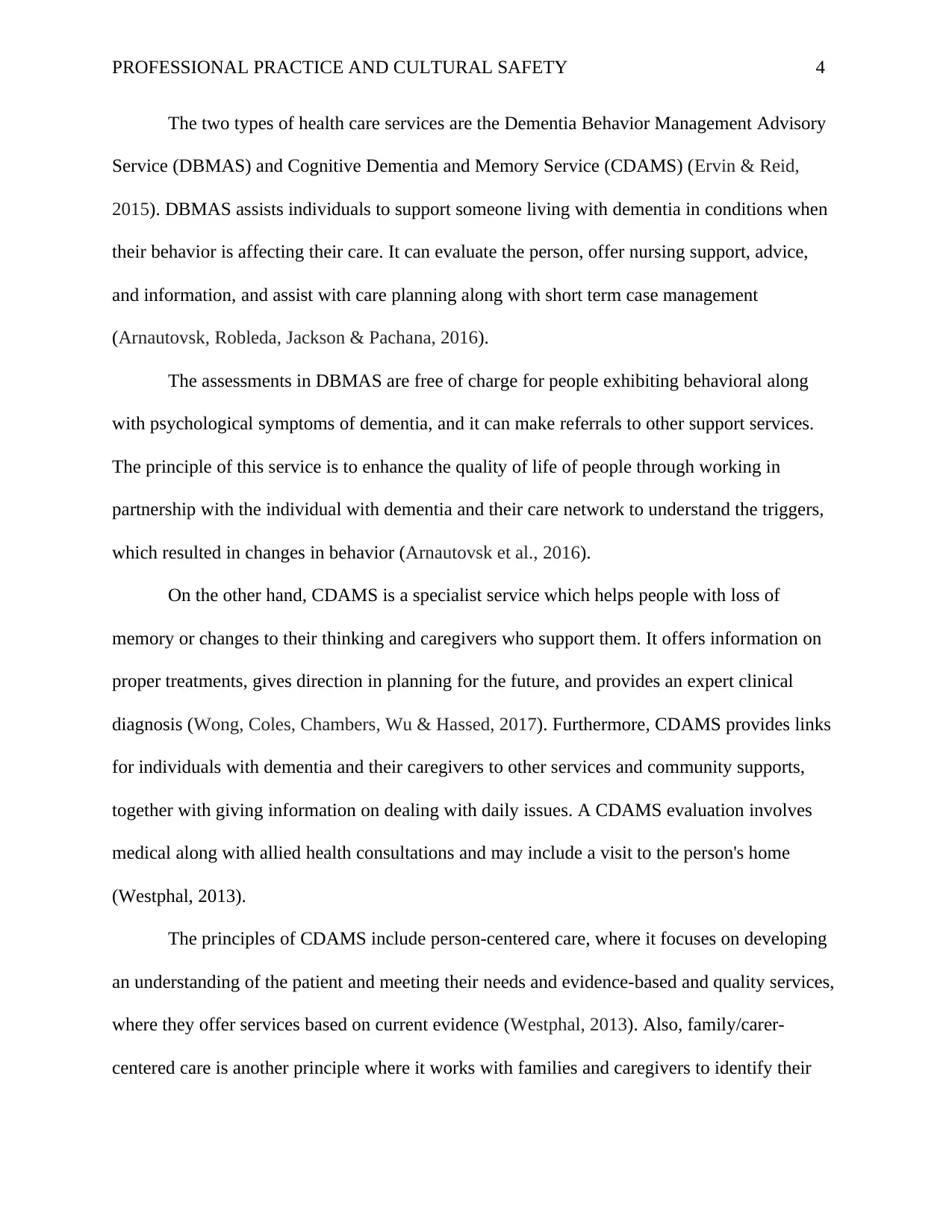
PROFESSIONAL PRACTICE AND CULTURAL SAFETY 4
The two types of health care services are the Dementia Behavior Management Advisory
Service (DBMAS) and Cognitive Dementia and Memory Service (CDAMS) (Ervin & Reid,
2015). DBMAS assists individuals to support someone living with dementia in conditions when
their behavior is affecting their care. It can evaluate the person, offer nursing support, advice,
and information, and assist with care planning along with short term case management
(Arnautovsk, Robleda, Jackson & Pachana, 2016).
The assessments in DBMAS are free of charge for people exhibiting behavioral along
with psychological symptoms of dementia, and it can make referrals to other support services.
The principle of this service is to enhance the quality of life of people through working in
partnership with the individual with dementia and their care network to understand the triggers,
which resulted in changes in behavior (Arnautovsk et al., 2016).
On the other hand, CDAMS is a specialist service which helps people with loss of
memory or changes to their thinking and caregivers who support them. It offers information on
proper treatments, gives direction in planning for the future, and provides an expert clinical
diagnosis (Wong, Coles, Chambers, Wu & Hassed, 2017). Furthermore, CDAMS provides links
for individuals with dementia and their caregivers to other services and community supports,
together with giving information on dealing with daily issues. A CDAMS evaluation involves
medical along with allied health consultations and may include a visit to the person's home
(Westphal, 2013).
The principles of CDAMS include person-centered care, where it focuses on developing
an understanding of the patient and meeting their needs and evidence-based and quality services,
where they offer services based on current evidence (Westphal, 2013). Also, family/carer-
centered care is another principle where it works with families and caregivers to identify their
The two types of health care services are the Dementia Behavior Management Advisory
Service (DBMAS) and Cognitive Dementia and Memory Service (CDAMS) (Ervin & Reid,
2015). DBMAS assists individuals to support someone living with dementia in conditions when
their behavior is affecting their care. It can evaluate the person, offer nursing support, advice,
and information, and assist with care planning along with short term case management
(Arnautovsk, Robleda, Jackson & Pachana, 2016).
The assessments in DBMAS are free of charge for people exhibiting behavioral along
with psychological symptoms of dementia, and it can make referrals to other support services.
The principle of this service is to enhance the quality of life of people through working in
partnership with the individual with dementia and their care network to understand the triggers,
which resulted in changes in behavior (Arnautovsk et al., 2016).
On the other hand, CDAMS is a specialist service which helps people with loss of
memory or changes to their thinking and caregivers who support them. It offers information on
proper treatments, gives direction in planning for the future, and provides an expert clinical
diagnosis (Wong, Coles, Chambers, Wu & Hassed, 2017). Furthermore, CDAMS provides links
for individuals with dementia and their caregivers to other services and community supports,
together with giving information on dealing with daily issues. A CDAMS evaluation involves
medical along with allied health consultations and may include a visit to the person's home
(Westphal, 2013).
The principles of CDAMS include person-centered care, where it focuses on developing
an understanding of the patient and meeting their needs and evidence-based and quality services,
where they offer services based on current evidence (Westphal, 2013). Also, family/carer-
centered care is another principle where it works with families and caregivers to identify their
Paraphrase This Document
Need a fresh take? Get an instant paraphrase of this document with our AI Paraphraser
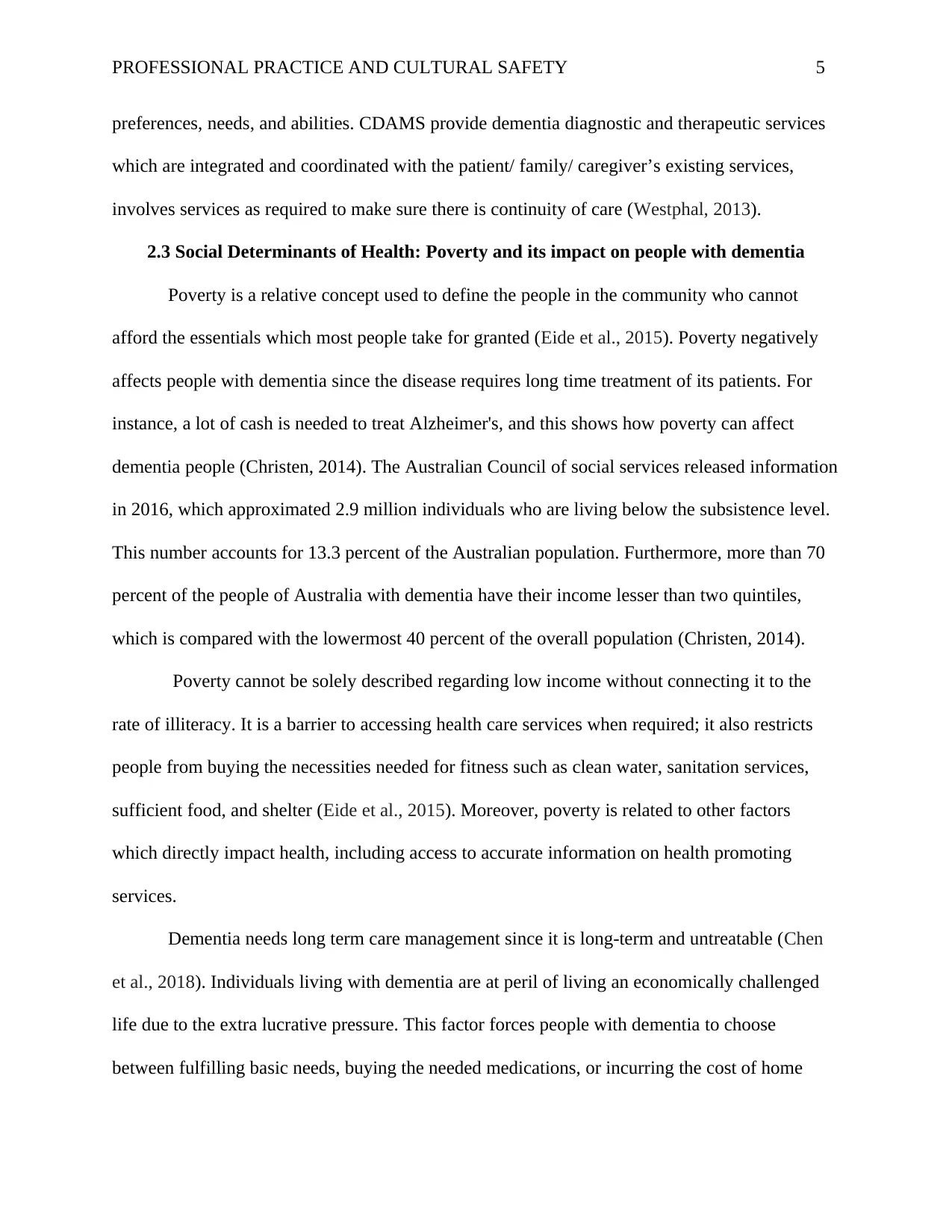
PROFESSIONAL PRACTICE AND CULTURAL SAFETY 5
preferences, needs, and abilities. CDAMS provide dementia diagnostic and therapeutic services
which are integrated and coordinated with the patient/ family/ caregiver’s existing services,
involves services as required to make sure there is continuity of care (Westphal, 2013).
2.3 Social Determinants of Health: Poverty and its impact on people with dementia
Poverty is a relative concept used to define the people in the community who cannot
afford the essentials which most people take for granted (Eide et al., 2015). Poverty negatively
affects people with dementia since the disease requires long time treatment of its patients. For
instance, a lot of cash is needed to treat Alzheimer's, and this shows how poverty can affect
dementia people (Christen, 2014). The Australian Council of social services released information
in 2016, which approximated 2.9 million individuals who are living below the subsistence level.
This number accounts for 13.3 percent of the Australian population. Furthermore, more than 70
percent of the people of Australia with dementia have their income lesser than two quintiles,
which is compared with the lowermost 40 percent of the overall population (Christen, 2014).
Poverty cannot be solely described regarding low income without connecting it to the
rate of illiteracy. It is a barrier to accessing health care services when required; it also restricts
people from buying the necessities needed for fitness such as clean water, sanitation services,
sufficient food, and shelter (Eide et al., 2015). Moreover, poverty is related to other factors
which directly impact health, including access to accurate information on health promoting
services.
Dementia needs long term care management since it is long-term and untreatable (Chen
et al., 2018). Individuals living with dementia are at peril of living an economically challenged
life due to the extra lucrative pressure. This factor forces people with dementia to choose
between fulfilling basic needs, buying the needed medications, or incurring the cost of home
preferences, needs, and abilities. CDAMS provide dementia diagnostic and therapeutic services
which are integrated and coordinated with the patient/ family/ caregiver’s existing services,
involves services as required to make sure there is continuity of care (Westphal, 2013).
2.3 Social Determinants of Health: Poverty and its impact on people with dementia
Poverty is a relative concept used to define the people in the community who cannot
afford the essentials which most people take for granted (Eide et al., 2015). Poverty negatively
affects people with dementia since the disease requires long time treatment of its patients. For
instance, a lot of cash is needed to treat Alzheimer's, and this shows how poverty can affect
dementia people (Christen, 2014). The Australian Council of social services released information
in 2016, which approximated 2.9 million individuals who are living below the subsistence level.
This number accounts for 13.3 percent of the Australian population. Furthermore, more than 70
percent of the people of Australia with dementia have their income lesser than two quintiles,
which is compared with the lowermost 40 percent of the overall population (Christen, 2014).
Poverty cannot be solely described regarding low income without connecting it to the
rate of illiteracy. It is a barrier to accessing health care services when required; it also restricts
people from buying the necessities needed for fitness such as clean water, sanitation services,
sufficient food, and shelter (Eide et al., 2015). Moreover, poverty is related to other factors
which directly impact health, including access to accurate information on health promoting
services.
Dementia needs long term care management since it is long-term and untreatable (Chen
et al., 2018). Individuals living with dementia are at peril of living an economically challenged
life due to the extra lucrative pressure. This factor forces people with dementia to choose
between fulfilling basic needs, buying the needed medications, or incurring the cost of home
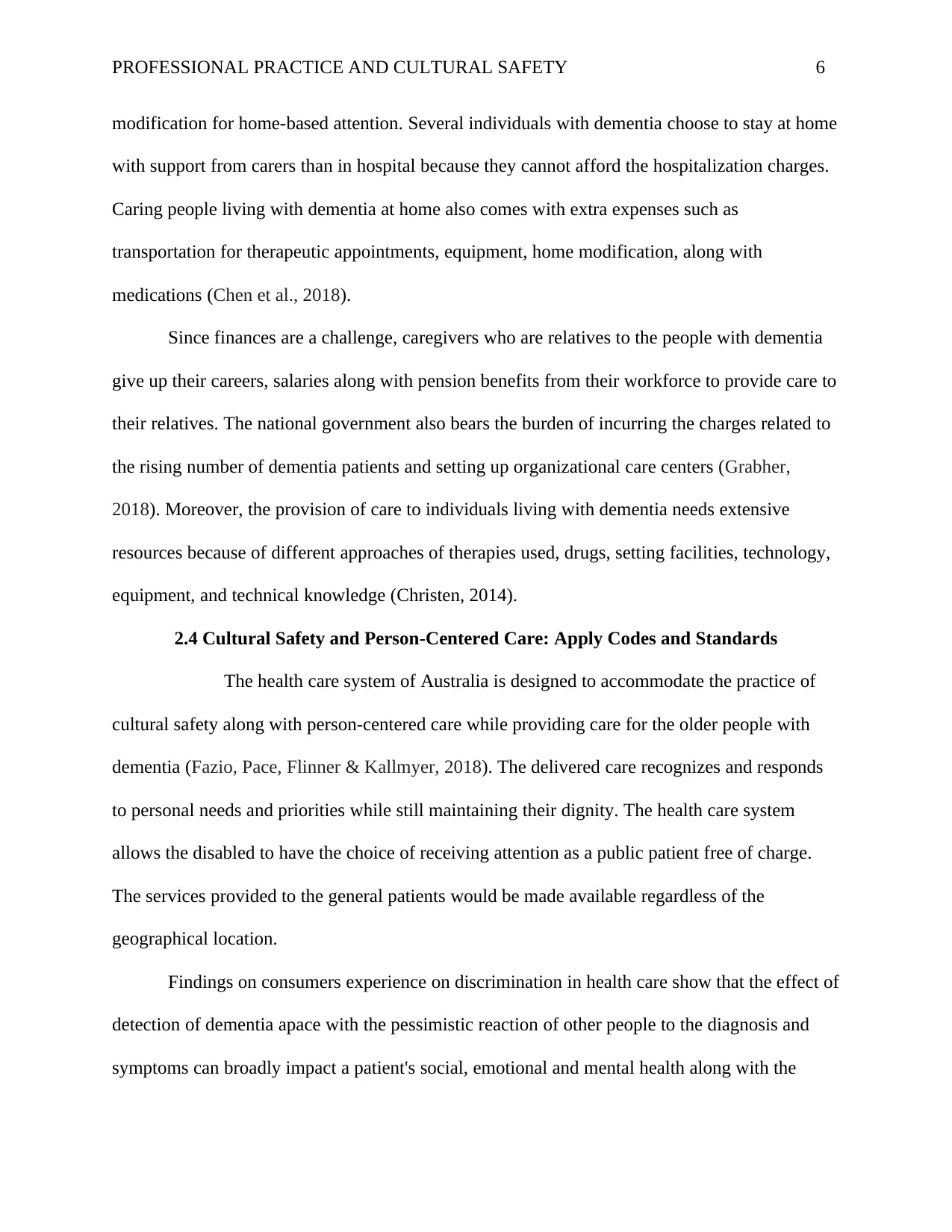
PROFESSIONAL PRACTICE AND CULTURAL SAFETY 6
modification for home-based attention. Several individuals with dementia choose to stay at home
with support from carers than in hospital because they cannot afford the hospitalization charges.
Caring people living with dementia at home also comes with extra expenses such as
transportation for therapeutic appointments, equipment, home modification, along with
medications (Chen et al., 2018).
Since finances are a challenge, caregivers who are relatives to the people with dementia
give up their careers, salaries along with pension benefits from their workforce to provide care to
their relatives. The national government also bears the burden of incurring the charges related to
the rising number of dementia patients and setting up organizational care centers (Grabher,
2018). Moreover, the provision of care to individuals living with dementia needs extensive
resources because of different approaches of therapies used, drugs, setting facilities, technology,
equipment, and technical knowledge (Christen, 2014).
2.4 Cultural Safety and Person-Centered Care: Apply Codes and Standards
The health care system of Australia is designed to accommodate the practice of
cultural safety along with person-centered care while providing care for the older people with
dementia (Fazio, Pace, Flinner & Kallmyer, 2018). The delivered care recognizes and responds
to personal needs and priorities while still maintaining their dignity. The health care system
allows the disabled to have the choice of receiving attention as a public patient free of charge.
The services provided to the general patients would be made available regardless of the
geographical location.
Findings on consumers experience on discrimination in health care show that the effect of
detection of dementia apace with the pessimistic reaction of other people to the diagnosis and
symptoms can broadly impact a patient's social, emotional and mental health along with the
modification for home-based attention. Several individuals with dementia choose to stay at home
with support from carers than in hospital because they cannot afford the hospitalization charges.
Caring people living with dementia at home also comes with extra expenses such as
transportation for therapeutic appointments, equipment, home modification, along with
medications (Chen et al., 2018).
Since finances are a challenge, caregivers who are relatives to the people with dementia
give up their careers, salaries along with pension benefits from their workforce to provide care to
their relatives. The national government also bears the burden of incurring the charges related to
the rising number of dementia patients and setting up organizational care centers (Grabher,
2018). Moreover, the provision of care to individuals living with dementia needs extensive
resources because of different approaches of therapies used, drugs, setting facilities, technology,
equipment, and technical knowledge (Christen, 2014).
2.4 Cultural Safety and Person-Centered Care: Apply Codes and Standards
The health care system of Australia is designed to accommodate the practice of
cultural safety along with person-centered care while providing care for the older people with
dementia (Fazio, Pace, Flinner & Kallmyer, 2018). The delivered care recognizes and responds
to personal needs and priorities while still maintaining their dignity. The health care system
allows the disabled to have the choice of receiving attention as a public patient free of charge.
The services provided to the general patients would be made available regardless of the
geographical location.
Findings on consumers experience on discrimination in health care show that the effect of
detection of dementia apace with the pessimistic reaction of other people to the diagnosis and
symptoms can broadly impact a patient's social, emotional and mental health along with the
⊘ This is a preview!⊘
Do you want full access?
Subscribe today to unlock all pages.

Trusted by 1+ million students worldwide
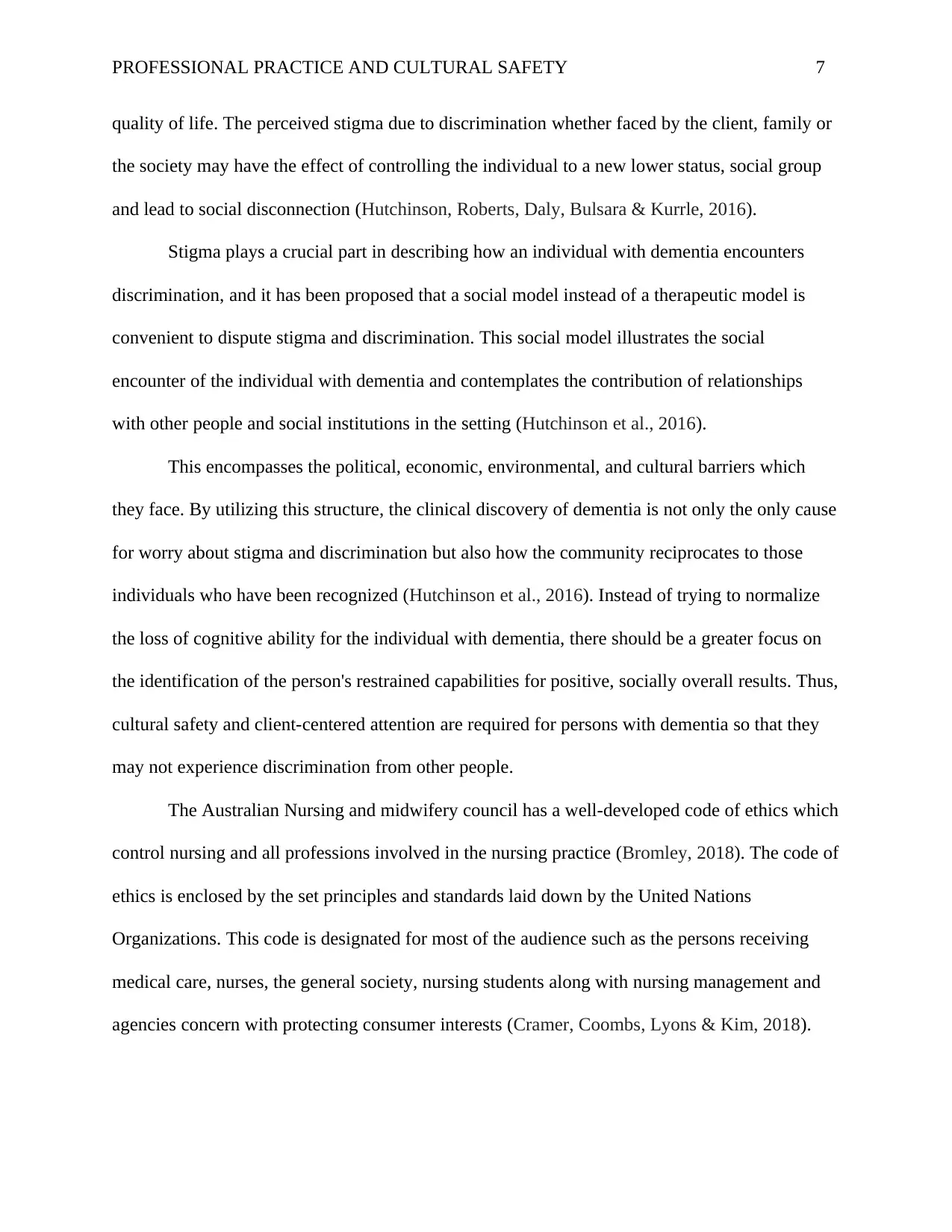
PROFESSIONAL PRACTICE AND CULTURAL SAFETY 7
quality of life. The perceived stigma due to discrimination whether faced by the client, family or
the society may have the effect of controlling the individual to a new lower status, social group
and lead to social disconnection (Hutchinson, Roberts, Daly, Bulsara & Kurrle, 2016).
Stigma plays a crucial part in describing how an individual with dementia encounters
discrimination, and it has been proposed that a social model instead of a therapeutic model is
convenient to dispute stigma and discrimination. This social model illustrates the social
encounter of the individual with dementia and contemplates the contribution of relationships
with other people and social institutions in the setting (Hutchinson et al., 2016).
This encompasses the political, economic, environmental, and cultural barriers which
they face. By utilizing this structure, the clinical discovery of dementia is not only the only cause
for worry about stigma and discrimination but also how the community reciprocates to those
individuals who have been recognized (Hutchinson et al., 2016). Instead of trying to normalize
the loss of cognitive ability for the individual with dementia, there should be a greater focus on
the identification of the person's restrained capabilities for positive, socially overall results. Thus,
cultural safety and client-centered attention are required for persons with dementia so that they
may not experience discrimination from other people.
The Australian Nursing and midwifery council has a well-developed code of ethics which
control nursing and all professions involved in the nursing practice (Bromley, 2018). The code of
ethics is enclosed by the set principles and standards laid down by the United Nations
Organizations. This code is designated for most of the audience such as the persons receiving
medical care, nurses, the general society, nursing students along with nursing management and
agencies concern with protecting consumer interests (Cramer, Coombs, Lyons & Kim, 2018).
quality of life. The perceived stigma due to discrimination whether faced by the client, family or
the society may have the effect of controlling the individual to a new lower status, social group
and lead to social disconnection (Hutchinson, Roberts, Daly, Bulsara & Kurrle, 2016).
Stigma plays a crucial part in describing how an individual with dementia encounters
discrimination, and it has been proposed that a social model instead of a therapeutic model is
convenient to dispute stigma and discrimination. This social model illustrates the social
encounter of the individual with dementia and contemplates the contribution of relationships
with other people and social institutions in the setting (Hutchinson et al., 2016).
This encompasses the political, economic, environmental, and cultural barriers which
they face. By utilizing this structure, the clinical discovery of dementia is not only the only cause
for worry about stigma and discrimination but also how the community reciprocates to those
individuals who have been recognized (Hutchinson et al., 2016). Instead of trying to normalize
the loss of cognitive ability for the individual with dementia, there should be a greater focus on
the identification of the person's restrained capabilities for positive, socially overall results. Thus,
cultural safety and client-centered attention are required for persons with dementia so that they
may not experience discrimination from other people.
The Australian Nursing and midwifery council has a well-developed code of ethics which
control nursing and all professions involved in the nursing practice (Bromley, 2018). The code of
ethics is enclosed by the set principles and standards laid down by the United Nations
Organizations. This code is designated for most of the audience such as the persons receiving
medical care, nurses, the general society, nursing students along with nursing management and
agencies concern with protecting consumer interests (Cramer, Coombs, Lyons & Kim, 2018).
Paraphrase This Document
Need a fresh take? Get an instant paraphrase of this document with our AI Paraphraser
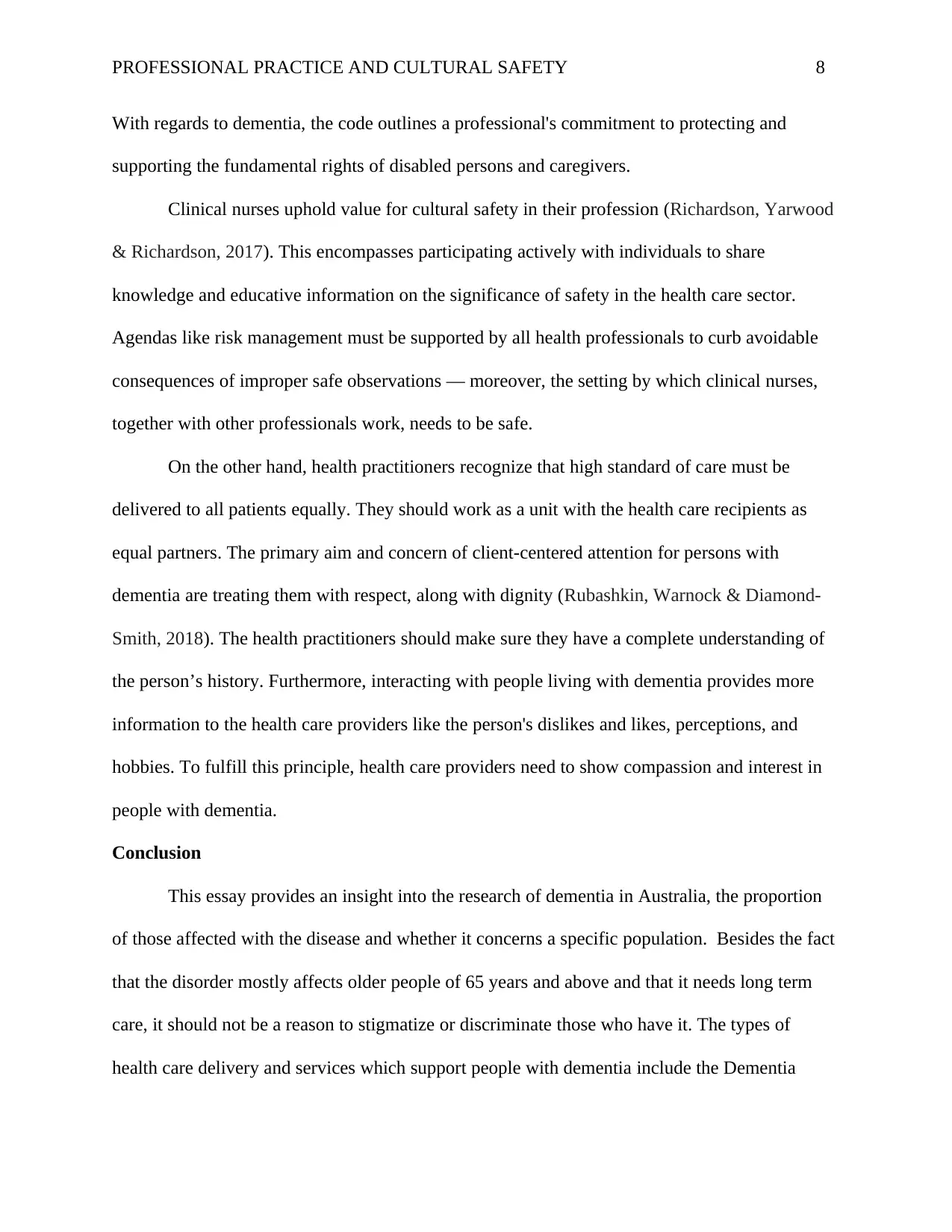
PROFESSIONAL PRACTICE AND CULTURAL SAFETY 8
With regards to dementia, the code outlines a professional's commitment to protecting and
supporting the fundamental rights of disabled persons and caregivers.
Clinical nurses uphold value for cultural safety in their profession (Richardson, Yarwood
& Richardson, 2017). This encompasses participating actively with individuals to share
knowledge and educative information on the significance of safety in the health care sector.
Agendas like risk management must be supported by all health professionals to curb avoidable
consequences of improper safe observations — moreover, the setting by which clinical nurses,
together with other professionals work, needs to be safe.
On the other hand, health practitioners recognize that high standard of care must be
delivered to all patients equally. They should work as a unit with the health care recipients as
equal partners. The primary aim and concern of client-centered attention for persons with
dementia are treating them with respect, along with dignity (Rubashkin, Warnock & Diamond-
Smith, 2018). The health practitioners should make sure they have a complete understanding of
the person’s history. Furthermore, interacting with people living with dementia provides more
information to the health care providers like the person's dislikes and likes, perceptions, and
hobbies. To fulfill this principle, health care providers need to show compassion and interest in
people with dementia.
Conclusion
This essay provides an insight into the research of dementia in Australia, the proportion
of those affected with the disease and whether it concerns a specific population. Besides the fact
that the disorder mostly affects older people of 65 years and above and that it needs long term
care, it should not be a reason to stigmatize or discriminate those who have it. The types of
health care delivery and services which support people with dementia include the Dementia
With regards to dementia, the code outlines a professional's commitment to protecting and
supporting the fundamental rights of disabled persons and caregivers.
Clinical nurses uphold value for cultural safety in their profession (Richardson, Yarwood
& Richardson, 2017). This encompasses participating actively with individuals to share
knowledge and educative information on the significance of safety in the health care sector.
Agendas like risk management must be supported by all health professionals to curb avoidable
consequences of improper safe observations — moreover, the setting by which clinical nurses,
together with other professionals work, needs to be safe.
On the other hand, health practitioners recognize that high standard of care must be
delivered to all patients equally. They should work as a unit with the health care recipients as
equal partners. The primary aim and concern of client-centered attention for persons with
dementia are treating them with respect, along with dignity (Rubashkin, Warnock & Diamond-
Smith, 2018). The health practitioners should make sure they have a complete understanding of
the person’s history. Furthermore, interacting with people living with dementia provides more
information to the health care providers like the person's dislikes and likes, perceptions, and
hobbies. To fulfill this principle, health care providers need to show compassion and interest in
people with dementia.
Conclusion
This essay provides an insight into the research of dementia in Australia, the proportion
of those affected with the disease and whether it concerns a specific population. Besides the fact
that the disorder mostly affects older people of 65 years and above and that it needs long term
care, it should not be a reason to stigmatize or discriminate those who have it. The types of
health care delivery and services which support people with dementia include the Dementia
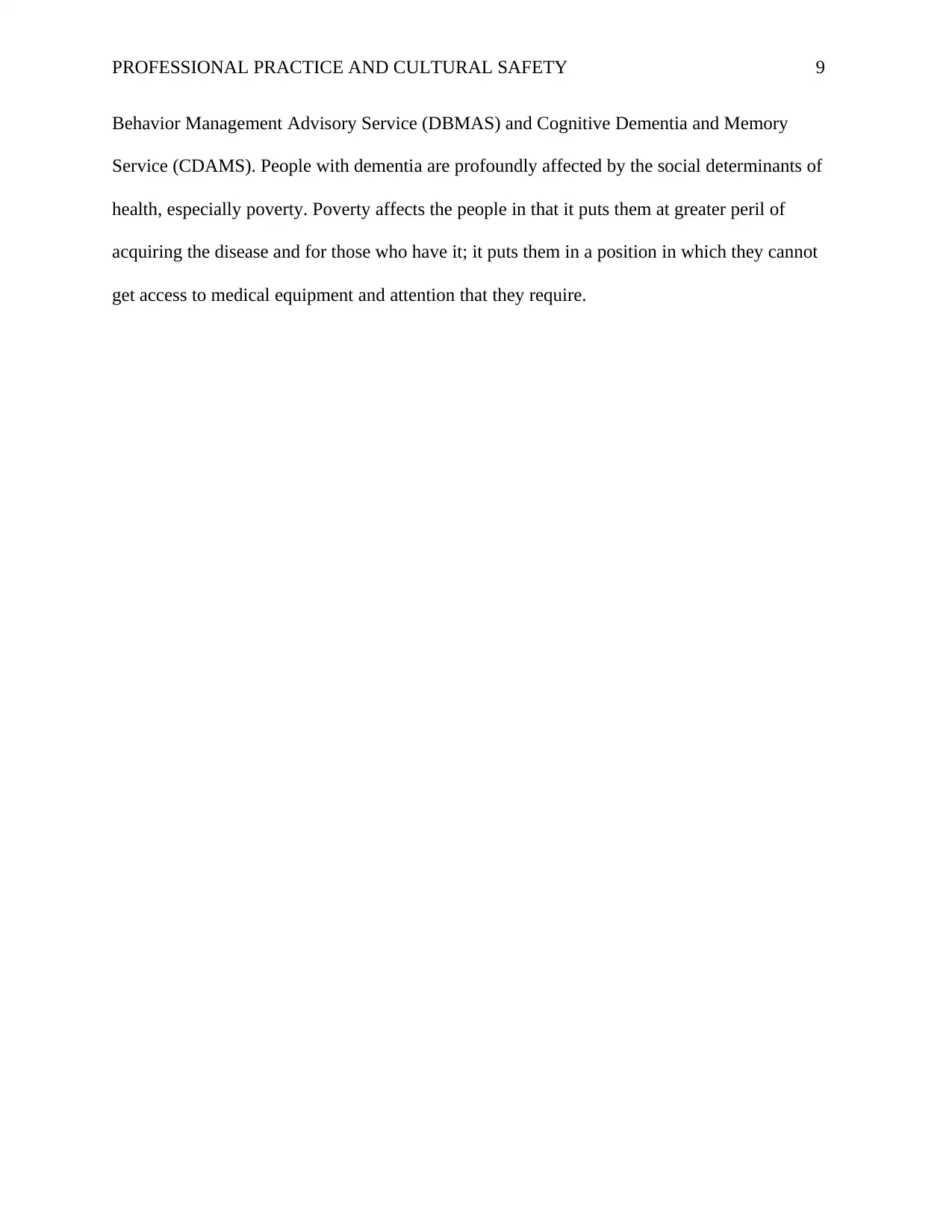
PROFESSIONAL PRACTICE AND CULTURAL SAFETY 9
Behavior Management Advisory Service (DBMAS) and Cognitive Dementia and Memory
Service (CDAMS). People with dementia are profoundly affected by the social determinants of
health, especially poverty. Poverty affects the people in that it puts them at greater peril of
acquiring the disease and for those who have it; it puts them in a position in which they cannot
get access to medical equipment and attention that they require.
Behavior Management Advisory Service (DBMAS) and Cognitive Dementia and Memory
Service (CDAMS). People with dementia are profoundly affected by the social determinants of
health, especially poverty. Poverty affects the people in that it puts them at greater peril of
acquiring the disease and for those who have it; it puts them in a position in which they cannot
get access to medical equipment and attention that they require.
⊘ This is a preview!⊘
Do you want full access?
Subscribe today to unlock all pages.

Trusted by 1+ million students worldwide
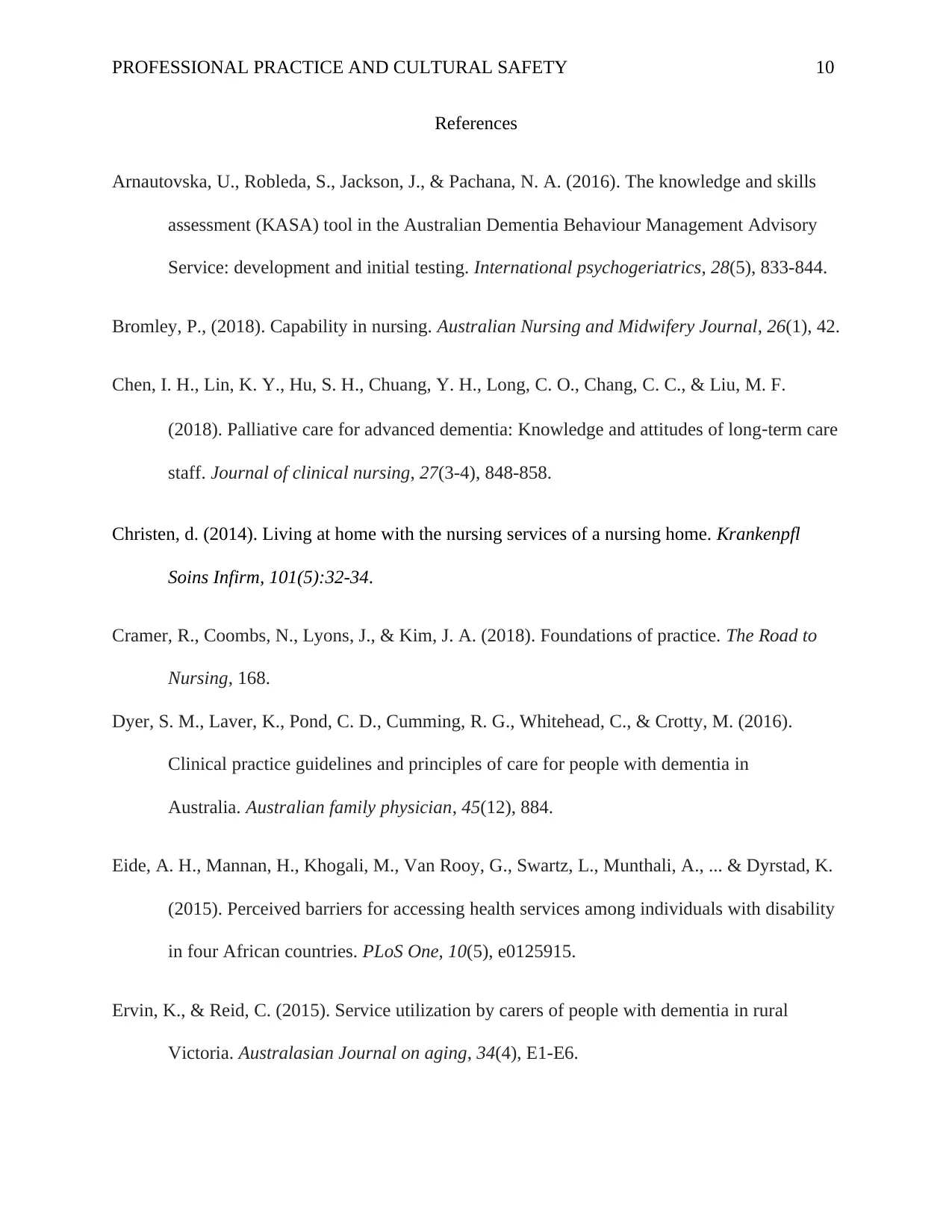
PROFESSIONAL PRACTICE AND CULTURAL SAFETY 10
References
Arnautovska, U., Robleda, S., Jackson, J., & Pachana, N. A. (2016). The knowledge and skills
assessment (KASA) tool in the Australian Dementia Behaviour Management Advisory
Service: development and initial testing. International psychogeriatrics, 28(5), 833-844.
Bromley, P., (2018). Capability in nursing. Australian Nursing and Midwifery Journal, 26(1), 42.
Chen, I. H., Lin, K. Y., Hu, S. H., Chuang, Y. H., Long, C. O., Chang, C. C., & Liu, M. F.
(2018). Palliative care for advanced dementia: Knowledge and attitudes of long‐term care
staff. Journal of clinical nursing, 27(3-4), 848-858.
Christen, d. (2014). Living at home with the nursing services of a nursing home. Krankenpfl
Soins Infirm, 101(5):32-34.
Cramer, R., Coombs, N., Lyons, J., & Kim, J. A. (2018). Foundations of practice. The Road to
Nursing, 168.
Dyer, S. M., Laver, K., Pond, C. D., Cumming, R. G., Whitehead, C., & Crotty, M. (2016).
Clinical practice guidelines and principles of care for people with dementia in
Australia. Australian family physician, 45(12), 884.
Eide, A. H., Mannan, H., Khogali, M., Van Rooy, G., Swartz, L., Munthali, A., ... & Dyrstad, K.
(2015). Perceived barriers for accessing health services among individuals with disability
in four African countries. PLoS One, 10(5), e0125915.
Ervin, K., & Reid, C. (2015). Service utilization by carers of people with dementia in rural
Victoria. Australasian Journal on aging, 34(4), E1-E6.
References
Arnautovska, U., Robleda, S., Jackson, J., & Pachana, N. A. (2016). The knowledge and skills
assessment (KASA) tool in the Australian Dementia Behaviour Management Advisory
Service: development and initial testing. International psychogeriatrics, 28(5), 833-844.
Bromley, P., (2018). Capability in nursing. Australian Nursing and Midwifery Journal, 26(1), 42.
Chen, I. H., Lin, K. Y., Hu, S. H., Chuang, Y. H., Long, C. O., Chang, C. C., & Liu, M. F.
(2018). Palliative care for advanced dementia: Knowledge and attitudes of long‐term care
staff. Journal of clinical nursing, 27(3-4), 848-858.
Christen, d. (2014). Living at home with the nursing services of a nursing home. Krankenpfl
Soins Infirm, 101(5):32-34.
Cramer, R., Coombs, N., Lyons, J., & Kim, J. A. (2018). Foundations of practice. The Road to
Nursing, 168.
Dyer, S. M., Laver, K., Pond, C. D., Cumming, R. G., Whitehead, C., & Crotty, M. (2016).
Clinical practice guidelines and principles of care for people with dementia in
Australia. Australian family physician, 45(12), 884.
Eide, A. H., Mannan, H., Khogali, M., Van Rooy, G., Swartz, L., Munthali, A., ... & Dyrstad, K.
(2015). Perceived barriers for accessing health services among individuals with disability
in four African countries. PLoS One, 10(5), e0125915.
Ervin, K., & Reid, C. (2015). Service utilization by carers of people with dementia in rural
Victoria. Australasian Journal on aging, 34(4), E1-E6.
Paraphrase This Document
Need a fresh take? Get an instant paraphrase of this document with our AI Paraphraser
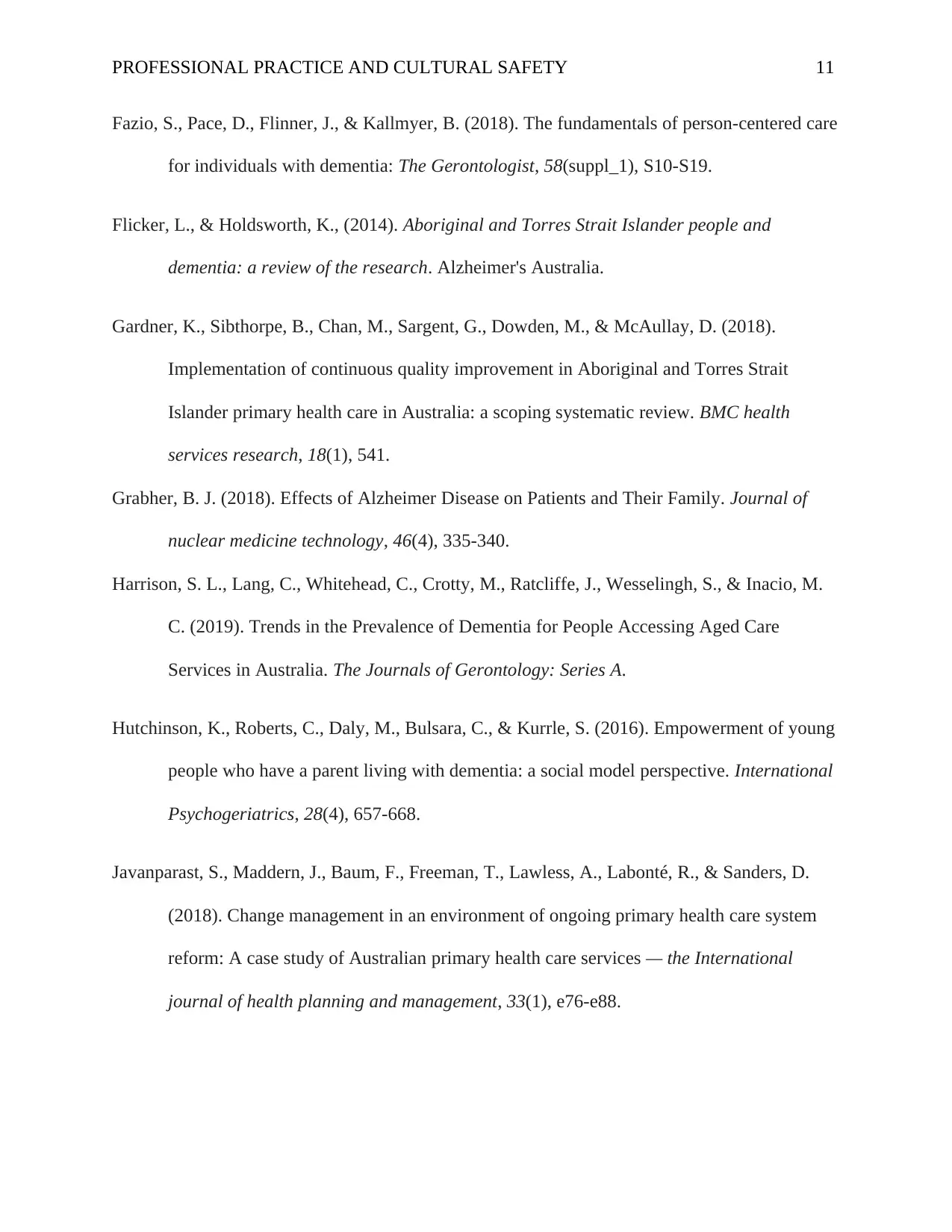
PROFESSIONAL PRACTICE AND CULTURAL SAFETY 11
Fazio, S., Pace, D., Flinner, J., & Kallmyer, B. (2018). The fundamentals of person-centered care
for individuals with dementia: The Gerontologist, 58(suppl_1), S10-S19.
Flicker, L., & Holdsworth, K., (2014). Aboriginal and Torres Strait Islander people and
dementia: a review of the research. Alzheimer's Australia.
Gardner, K., Sibthorpe, B., Chan, M., Sargent, G., Dowden, M., & McAullay, D. (2018).
Implementation of continuous quality improvement in Aboriginal and Torres Strait
Islander primary health care in Australia: a scoping systematic review. BMC health
services research, 18(1), 541.
Grabher, B. J. (2018). Effects of Alzheimer Disease on Patients and Their Family. Journal of
nuclear medicine technology, 46(4), 335-340.
Harrison, S. L., Lang, C., Whitehead, C., Crotty, M., Ratcliffe, J., Wesselingh, S., & Inacio, M.
C. (2019). Trends in the Prevalence of Dementia for People Accessing Aged Care
Services in Australia. The Journals of Gerontology: Series A.
Hutchinson, K., Roberts, C., Daly, M., Bulsara, C., & Kurrle, S. (2016). Empowerment of young
people who have a parent living with dementia: a social model perspective. International
Psychogeriatrics, 28(4), 657-668.
Javanparast, S., Maddern, J., Baum, F., Freeman, T., Lawless, A., Labonté, R., & Sanders, D.
(2018). Change management in an environment of ongoing primary health care system
reform: A case study of Australian primary health care services — the International
journal of health planning and management, 33(1), e76-e88.
Fazio, S., Pace, D., Flinner, J., & Kallmyer, B. (2018). The fundamentals of person-centered care
for individuals with dementia: The Gerontologist, 58(suppl_1), S10-S19.
Flicker, L., & Holdsworth, K., (2014). Aboriginal and Torres Strait Islander people and
dementia: a review of the research. Alzheimer's Australia.
Gardner, K., Sibthorpe, B., Chan, M., Sargent, G., Dowden, M., & McAullay, D. (2018).
Implementation of continuous quality improvement in Aboriginal and Torres Strait
Islander primary health care in Australia: a scoping systematic review. BMC health
services research, 18(1), 541.
Grabher, B. J. (2018). Effects of Alzheimer Disease on Patients and Their Family. Journal of
nuclear medicine technology, 46(4), 335-340.
Harrison, S. L., Lang, C., Whitehead, C., Crotty, M., Ratcliffe, J., Wesselingh, S., & Inacio, M.
C. (2019). Trends in the Prevalence of Dementia for People Accessing Aged Care
Services in Australia. The Journals of Gerontology: Series A.
Hutchinson, K., Roberts, C., Daly, M., Bulsara, C., & Kurrle, S. (2016). Empowerment of young
people who have a parent living with dementia: a social model perspective. International
Psychogeriatrics, 28(4), 657-668.
Javanparast, S., Maddern, J., Baum, F., Freeman, T., Lawless, A., Labonté, R., & Sanders, D.
(2018). Change management in an environment of ongoing primary health care system
reform: A case study of Australian primary health care services — the International
journal of health planning and management, 33(1), e76-e88.
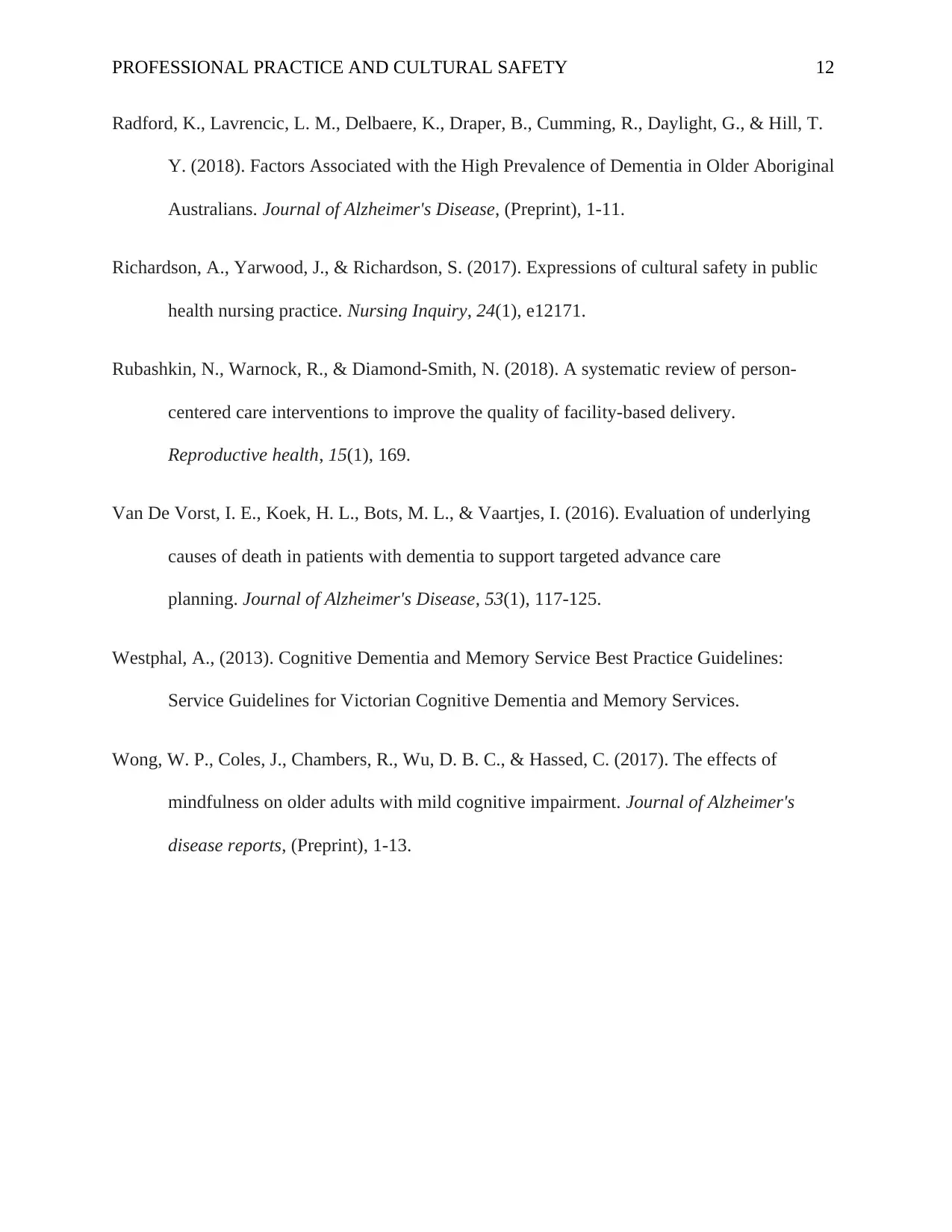
PROFESSIONAL PRACTICE AND CULTURAL SAFETY 12
Radford, K., Lavrencic, L. M., Delbaere, K., Draper, B., Cumming, R., Daylight, G., & Hill, T.
Y. (2018). Factors Associated with the High Prevalence of Dementia in Older Aboriginal
Australians. Journal of Alzheimer's Disease, (Preprint), 1-11.
Richardson, A., Yarwood, J., & Richardson, S. (2017). Expressions of cultural safety in public
health nursing practice. Nursing Inquiry, 24(1), e12171.
Rubashkin, N., Warnock, R., & Diamond-Smith, N. (2018). A systematic review of person-
centered care interventions to improve the quality of facility-based delivery.
Reproductive health, 15(1), 169.
Van De Vorst, I. E., Koek, H. L., Bots, M. L., & Vaartjes, I. (2016). Evaluation of underlying
causes of death in patients with dementia to support targeted advance care
planning. Journal of Alzheimer's Disease, 53(1), 117-125.
Westphal, A., (2013). Cognitive Dementia and Memory Service Best Practice Guidelines:
Service Guidelines for Victorian Cognitive Dementia and Memory Services.
Wong, W. P., Coles, J., Chambers, R., Wu, D. B. C., & Hassed, C. (2017). The effects of
mindfulness on older adults with mild cognitive impairment. Journal of Alzheimer's
disease reports, (Preprint), 1-13.
Radford, K., Lavrencic, L. M., Delbaere, K., Draper, B., Cumming, R., Daylight, G., & Hill, T.
Y. (2018). Factors Associated with the High Prevalence of Dementia in Older Aboriginal
Australians. Journal of Alzheimer's Disease, (Preprint), 1-11.
Richardson, A., Yarwood, J., & Richardson, S. (2017). Expressions of cultural safety in public
health nursing practice. Nursing Inquiry, 24(1), e12171.
Rubashkin, N., Warnock, R., & Diamond-Smith, N. (2018). A systematic review of person-
centered care interventions to improve the quality of facility-based delivery.
Reproductive health, 15(1), 169.
Van De Vorst, I. E., Koek, H. L., Bots, M. L., & Vaartjes, I. (2016). Evaluation of underlying
causes of death in patients with dementia to support targeted advance care
planning. Journal of Alzheimer's Disease, 53(1), 117-125.
Westphal, A., (2013). Cognitive Dementia and Memory Service Best Practice Guidelines:
Service Guidelines for Victorian Cognitive Dementia and Memory Services.
Wong, W. P., Coles, J., Chambers, R., Wu, D. B. C., & Hassed, C. (2017). The effects of
mindfulness on older adults with mild cognitive impairment. Journal of Alzheimer's
disease reports, (Preprint), 1-13.
⊘ This is a preview!⊘
Do you want full access?
Subscribe today to unlock all pages.

Trusted by 1+ million students worldwide
1 out of 12
Related Documents
Your All-in-One AI-Powered Toolkit for Academic Success.
+13062052269
info@desklib.com
Available 24*7 on WhatsApp / Email
![[object Object]](/_next/static/media/star-bottom.7253800d.svg)
Unlock your academic potential
Copyright © 2020–2025 A2Z Services. All Rights Reserved. Developed and managed by ZUCOL.





